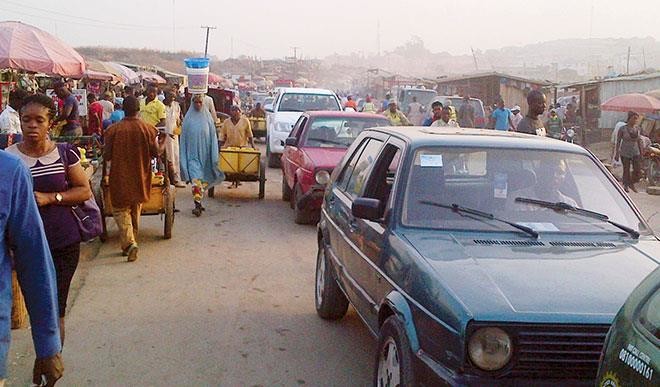
It was christened by migrants from one of the biggest slums in the country who moved into the nation’s capital seeking better economic prospects. It is located in a grimy slum on the fringes of Abuja’s city centre, and has no facilities that can classify it as urban, but it is too noisy and polluted to be termed rural.
A group of settlers migrated from where many refer to as the “jungle city” of Lagos to the Federal Capital in the late 80s, with little knowledge about the territory they planned to make their new home. The high cost of securing a befitting accommodation has pushed many into settling in slums; these migrants are no exception. They settled in an area and christened it “Ajegunle.”
“As with other migrants from the length and breadth of Nigeria, we relocated to Abuja in search of better employment and business opportunities. Few weeks after our arrival, we settled in a place in Mpape a distance away from the indigenes. At that time, the area was bushy with few houses in place and it had no name. We decided to name it Ajegunle because we lived in the Ajegunle area of Lagos,” says Oba Musibau Adekale, the Yoruba chief in Mpape.
This, according to the chief, was done in order for them to have a feel of their former homes, which he says bear some resemblance to their new location.
In Lagos, Ajegunle is a mega slum infamous for its overcrowding, poverty and lack of sanitation. However, the slum is getting a major revamp with the provision of some facilities. Schools, hospitals and roads exist, although the staggering population of the area is overstretching these facilities.
Abuja’s Ajegunle is a sprawling slum that develops in the hills of Mpape, a largely informal settlement just outside the expressway, which circles the city centre. Mpape is one of the slums that dot the mega city with low-priced houses springing up by the day in the shadow of gleaming high rise and luxury buildings.
The most striking point about Abuja’s slums is their close proximity to shimmering luxury houses, often in the very heart of the city. The city is now a curious juxtaposition of rich and poor , that has yuppie executives looking down from high-rise buildings onto landscapes of ramshackle huts and open sewage.
Mpape is home to a number of mining sites owned by major construction companies in Nigeria.But neglected by regulatory authorities for decades, residential areas have developed side-by-side with quarry sites.
“During the early days of Ajegunle, the construction workers blasting the hills helped in clearing the bushes and grading the roads. A construction company blasting the hills installed one giant light which illuminated the entire community at night because there was no electricity,” Oba Musibau comments, adding “basic amenities are non-existent, while residents always rely on self-help efforts to get the necessities.”
The major road leading to Ajegunle is a right exit from Murtala Mohammed Expressway, which takes you to the Mpape road. There, a few kilometres from the highway, a sweltering surge of humanity confronts you. The road disappears under the mass of people. Street traders, water vendors, commercial motorcyclists, take over what is left of the road.They only make way when a vehicle approaches.
In Ajegunle, cramped alleyways and mishmash structures lean into and grow out of each other. Kids careened down the rocky, dirt streets at full speed, while music soared out of a set of speakers at a record store. The population is bursting at the seams and growing by hundreds a year.The population of residents is put at about a million people. This number grows rapidly as a vast majority move from the countryside to the nation’s capital in search of greener pastures, most of them settling in slums.
The community could be a model for a study of the environmental impact of informal settlements, with no state-sponsored infrastructure like clean water, sanitation, healthcare or electricity. This, according to a resident, John Emmanuel, is because, as far as government is concerned, residents are squatters, who lack leases or legal title to their homes.
Residents see the population density of the slum as a blessing rather than a curse. The slum is a thriving economic hub. Shops dot nearly every corner. There wasn’t a square of street front property without activity: pharmacies, restaurants, grocery stores line the streets.
“Ajegunle has its problems, but it’s a nice place to live,” says Emmanuel. “At least you can do a petty business and get a little to get by. Back home in the village, it’s really hard to survive.”
It was early in the evening when I left Oba Musibau’s compound ,and the crowds streamed in from their jobs in the rest of the city. Amid honking horns, stall owners swept through the gridlock peddling a mind-boggling array of wares. Men and women picked their way through the streets, grabbing up last-minute items before heading home for the night.
“The population is much now,” says the Igede chief, Jacob Obor. “In the morning when residents are going to their various offices and workshops, Okada riders smile to the bank. Residents troop out in large numbers in the morning and same in the evening when they return from work. Some people have to trek a long distance to the expressway due to traffic congestion.”
Residents, he adds, have developed coping mechanisms to deal with the traffic congestion in the area “To get ahead of the rush, some people wake up as early as 5a.m. to drive to work.”
The nagging feeling of being left behind, also weighs heavily on residents of Ajegunle. Chief Obor reels off their woes: “No electricity, hospital, schools and roads.”
As the population increases, there is no corresponding development of infrastructure . The few but overstretched amenities are primarily the products of residents’ self-help efforts. Local associations collect levies from the neighbours and collectively invest in transformers and other electricity infrastructure, and maintain roads. Residents have always dreaded the rains. When they arrive in May, Obor says, sewage floods homes in the low-lying areas.
“In the entire Mpape, there is only one primary and secondary school. If you come to Mpape in the morning, you see school children crammed in a big truck that belongs to a construction company, conveying them to their various schools in distant places.There is no single borehole drilled by government here , while the health post serving the entire Ajegunle is actually half of my parlour. Electricity supply is erratic but bills are high. During the rainy season, the poor state of our road makes it difficult for us to move around ,” he laments.
Bukola Ibikunle, who lives close to a dumpsite, says she was worried over the health implication of indiscriminate disposal of refuse. She says inadequate waste management and poor drainage infrastructure has caused toxic pollution, and water-borne diseases, even as the pools of rainwater resulting from floods during heavy downpours, have now become breeding grounds for mosquitoes.
Obor appeals to government to “grade our roads, build hospitals and more schools for our children.” He says “At the town hall meeting which holds once a month, we discuss these issues and even delegate some residents to relay our complaints to the authorities.”
The tragedy of Ajegunle can be seen in the Federal Capital Territory Administration’s refusal to grant residents formal recognition to land ownership, and this has caused the area to be included among the slums in FCT marked for demolition by previous government of FCT.
“They neglected the area when it was bushy. Now that the community has developed, they are attempting to eject us,” Ambrose Odeh fumes.
In 2012, FCTA announced plans to demolish 19 villages in Abuja suburbs, including the entirety of Mpape, in an effort to restore the Abuja master plan. Numerous houses were marked for demolition in different areas of Mpape including Ajegunle, Eneje, Mashafa, Area 1, among others.
Odeh, who has lived in Ajegunle for over 20 years, recalls that palpable fear gripped the entire community when the news of demolition filtered in, compelling many to sell off their properties at cheap prices.
“We reacted quickly to the threatened demolition. We contacted National Human Rights Commission (NHRC), organised a peaceful protest to the National Assembly and got the demolition into the public domain,” Odeh says.
He said the case, filed by a team of lawyers, including the human rights activist, Femi Falana, challenging the legality of the demolition, is still in court.
“We are not quarreling over land with the government; we are appealing because you cannot forcefully eject about two million people without resettling them. There are lots of empty lands within our neighbourhood that stretches to Kaduna road. They should resettle us there,” he added.

 Join Daily Trust WhatsApp Community For Quick Access To News and Happenings Around You.
Join Daily Trust WhatsApp Community For Quick Access To News and Happenings Around You.



